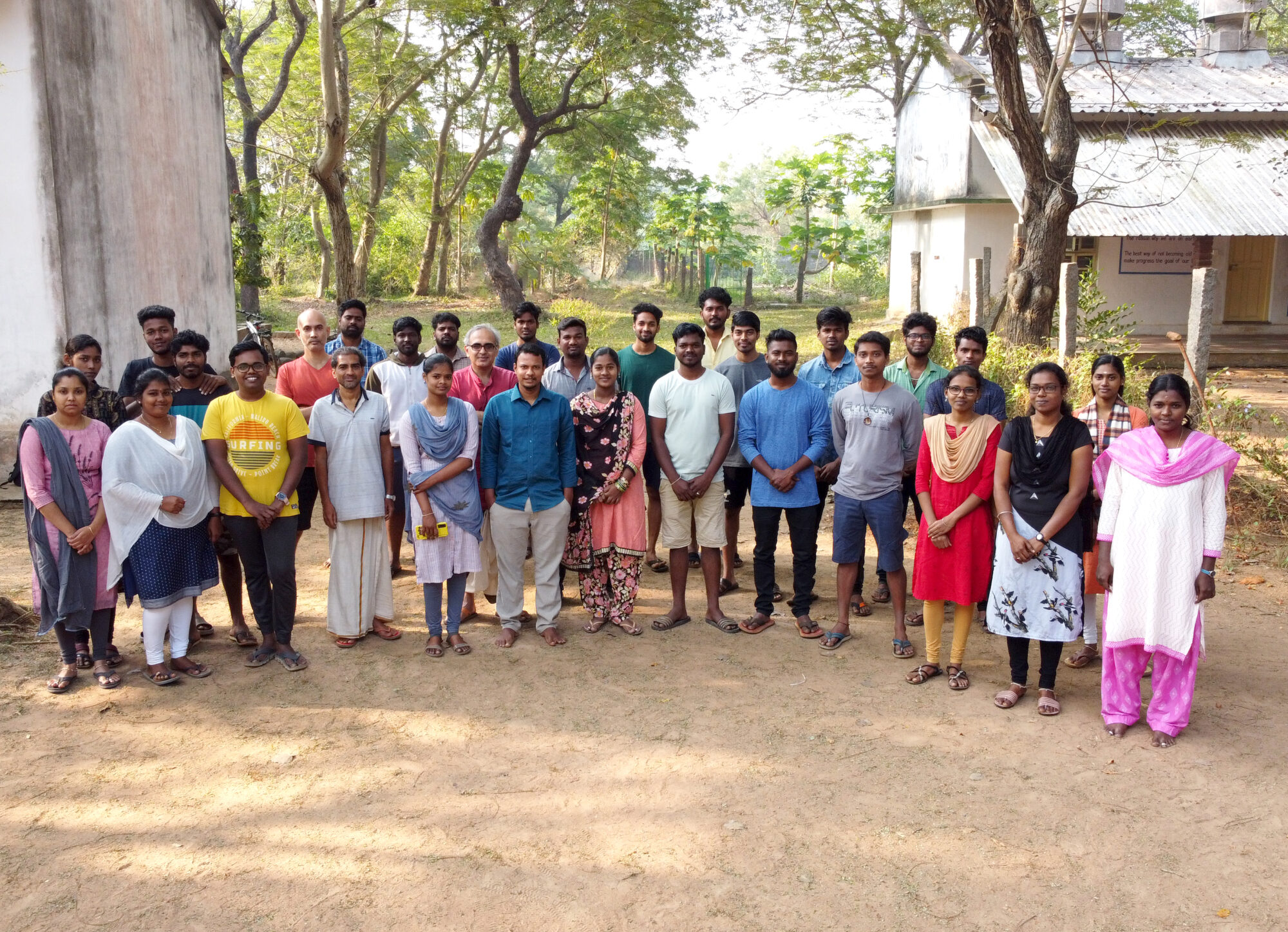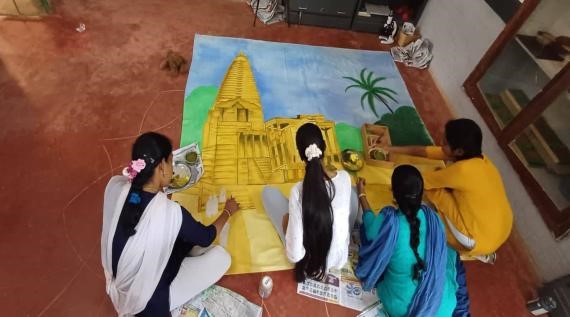Mathegramming Academy aims to build Responsibility and Rigor in children and generate Results through mentoring and mastery of Mathematics through projects in programming/electronics, and through leadership in action. Mathegramming Academy is a program of C3STREAM Land Designs, Auroville

Philosophies Underlying Mathegramming Academy
The philosophy underlying the approach for C3SLD is based on the principles of progressive and constructivist thinkers like Jerome Bruner, and Seymour Papert in the United States, and Sri Aurobindo in India. The philosophy of Sri Aurobindo of the integral development of the child and emphasizes self-knowledge which the National Education Policy is based on stating “knowledge is a deep-seated treasure and education helps in its manifestation as the perfection which is already within an individual.” The philosophy creates guiding principles as teachers and in how we engage with children.
MATHEGRAMMING ACADEMY’S
baby step
Collaboration with VAASAVI INTERNATIONAL SCHOOL – CBSE in
training teachers on Mathematics through programming and leadership program .
The three principles of true education by Sri Aurobindo are:
- Nothing can be taught which can be linked to the constructivist theory of not forcing knowledge into a child.
- The mind needs to be consulted in its own growth indicating that the role of a teacher is not to mould or hammer a child into the form desired by the adult. The teacher is a guide, or mentor that supports and encourages a child in the process of learning, enabling them to evolve toward perfection
- From near to far – which is to work from what is tangible and accessible to children to what is abstract to them
These principles guide our work at C3SLD where Mathegramming is codifying the work that has been done with children over the last 10 years.
A session on GeoGebra tools by Mathegramming Academy:
GeoGebra is a free and open-source interactive mathematics software that allows users to create and manipulate mathematical models, graphs, and figures.
Teachers at STEM Land have already been using GeoGebra for some classroom demonstrations, and the Mathegramming Academy presented a session on GeoGebra that would step up their ability to interact and engage with children and create interactive projects and 3D models.
Dharani presented how to create a GeoGebra activity and then a classroom for students to be able to do tasks and for the instructor to be able to observe the progress in real-time. Dharani created a classroom with many activities and then one that let someone work with a GeoGebra sheet. The rest of the session was done in this classroom which allowed everyone to see the progress of individuals signed in.

- Sivashankar presented how to create a circumcentre, circumcircle, incentre, and incircle for a triangle. To move the triangle points and see how the construction refreshes and holds. Also, to add color and character to the projects. on how to create a circumcentre, circumcircle, incentre, and incircle for a triangle.

- Premkumar presented how to create a 11^3as (10+1)^3 visually as a 3D construction with polygon and prism extension.

- Soundariya presented how to create interactive (and randomized) questions and answers and provide input boxes and buttons and respond to the user’s inputs using the if condition.

The session was intense for 1-1/2 hrs and was enjoyable and enlightening.
Breakthrough meeting of Mathegramming Academy
Date: May 20, 2023
Agenda:
Review Integrity
Discussion of new goals and objectives
Blogs and Weekly update Scaling Stemland
Friday Activity Class
Action Plan
Integrity Check
The team had an integrity check in the previous action plan and discussed what went well and what could be improved.
The team agreed that they will hold integrity to make good progress on their goals but could have been more organized and efficient.
New Goals and Objectives
The Mathegramming Academy team is excited to announce our new goals and objectives for the upcoming weeks. We are committed to making modules exploring Geogebra, Scratch, and Electronics.
– Our first goal is to make Mathegramming Academy more accessible to everyone. We want to make it easy for anyone to take support from Mathegramming Academy.
We believe that these new goals will help us to make Mathegramming Academy a valuable asset to rely on for everyone.
We are excited to work towards these goals and look forward to sharing our progress with you.
They agreed that they wanted to focus on increasing their reach and engagement, website development, and developing new and innovative ways to teach math.

Blogs and Weekly Update
As the team members should write a blog at the end of the week about what they learned and worked
Sending weekly updates on time and Weekly team updates would be sent by taking turns.
Accountability in Stem land
In Mathegramming Academy each person has to take responsibility for Stem land.
How to manage stocks, website management, puzzles, News Letters, Videos, Visitor Management, Stem land(fest), etc.
Action Plan
The team agreed to take the following next steps:
- Develop a CFSR for the website
- Pre-presentation on Thursdays for the presentation on Fridays at 11 am.
- Meet daily from 3’o clock to 4’o clock to review daily learnings and progress.
- The team is excited to continue working on its mission to make math more accessible and engaging for everyone.

Design session for Mathegramming Academy:
A design session in radical
transformational leadership is a process of creating a vision for the future and then developing a plan to achieve that vision.
It is a leadership program that supports learning what I deeply care about and aligning it with systems shifts and strategic action.
The Mathegramming Academy attended the session which was held on the 24th and 26th of May.
The design session began with a group of people coming together to share their projects. This was hosted by Dr.Sudharshan from RTL Works. This is followed by a discussion of the challenges that must be overcome to achieve these projects. Once the challenges are identified, the group works together to develop a plan of action.
The action plan should be specific, measurable, achievable, relevant, and time-bound. It should also be based on the group’s values and beliefs. Once the plan is in place, the group can begin to implement it. The design session allows the group to come together, share their ideas, and develop a plan for change. The action plan can then be used to guide the group’s efforts and help them achieve their goals
In the session, the Mathegramming team discussed the following with the RTL works by presenting the three templates of architecture for equitable and sustainable change. Dharani from the Mathegramming team presented the templates with the inputs from the rest of the team. The templates are the Conscious full spectrum response model, Respond and realize, and Synergistic operational strategies.
Defining the problem or opportunity. What is the issue that the group is trying to address? What are the opportunities that the group is seeking to exploit?
Identifying the stakeholders. Who are the people who will be affected by the change? What are their needs and interests?
Generated ideas. Made a list of possible solutions to the problem or opportunity.
Evaluated the ideas. Assessed the feasibility and potential impact of each idea.
Chose a course of action. Selected the best idea and develop an implementation plan.
Implementing the plan. Putting the plan into action and monitoring its progress.
Evaluating the results. To assess the impact of the change and make necessary adjustments.

The session was an eye-opener and paved the way to look at different and multiple perspectives of the project. It narrowed the gaps in the project. It was interesting. We thank the RTL workers for their time and feedback. We look forward to being in action.
Mathegramming Academy explores Pygame
Mathegramming Academy explores different platforms of programming every month since it started. First, we worked on scratch programming and later worked on GeoGebra projects.
This month we looked into Python and started doing projects in Pygame implementing mathematical concepts.
We learned basic programming by doing a guided project in the course era and made a pong game.
Pygame is a powerful and popular open-source library that provides functionality for building 2D games and multimedia applications using Python. We explored different simplest installations for using Python coding. We compared the installation time, size, inbuilt modules, and packages, steps involved in the installation, and arrived at the most feasible and operational way of PyCharm as children will be using it for learning .

Once Python is installed, we proceeded with installing Pygame.
We made projects on pong game,squares visualization , fractions and so on.

We still continue to explore Pygame and extend to make projects in it using maths concepts.The journey is fascinating.


Working in Alignment with School Curriculum and School Reopening
As schools begin to reopen, it is important for Mathegramming Academy to work in alignment with the school curriculum.
This will help ensure that students are able to make the most of their learning opportunities and continue to progress academically.
We started with the specific learning goals for the year. This will help us with a better understanding of what your child is expected to learn and how we can help them.
We focused on creating opportunities to practice what they are learning in school. This could involve reading books, doing math problems, or working on maths projects.

It is also important to be supportive of your child’s learning. This means providing them with positive reinforcement and encouragement. It also means being patient and understanding when they are struggling.
Working in alignment with the school curriculum is an important way to support your child’s learning.

Contributions towards Mathegramming Academy can be directed towards:
Auroville Unity Fund With a note for STEM land and mail it to
Dr. Sanjeev Ranganathan, STEM land Udavi School, Auroville, Edayanchavadi, Tamil
Nadu – 605101 (All donations are 100% tax-deductible in India). www.auraauro.com




























































